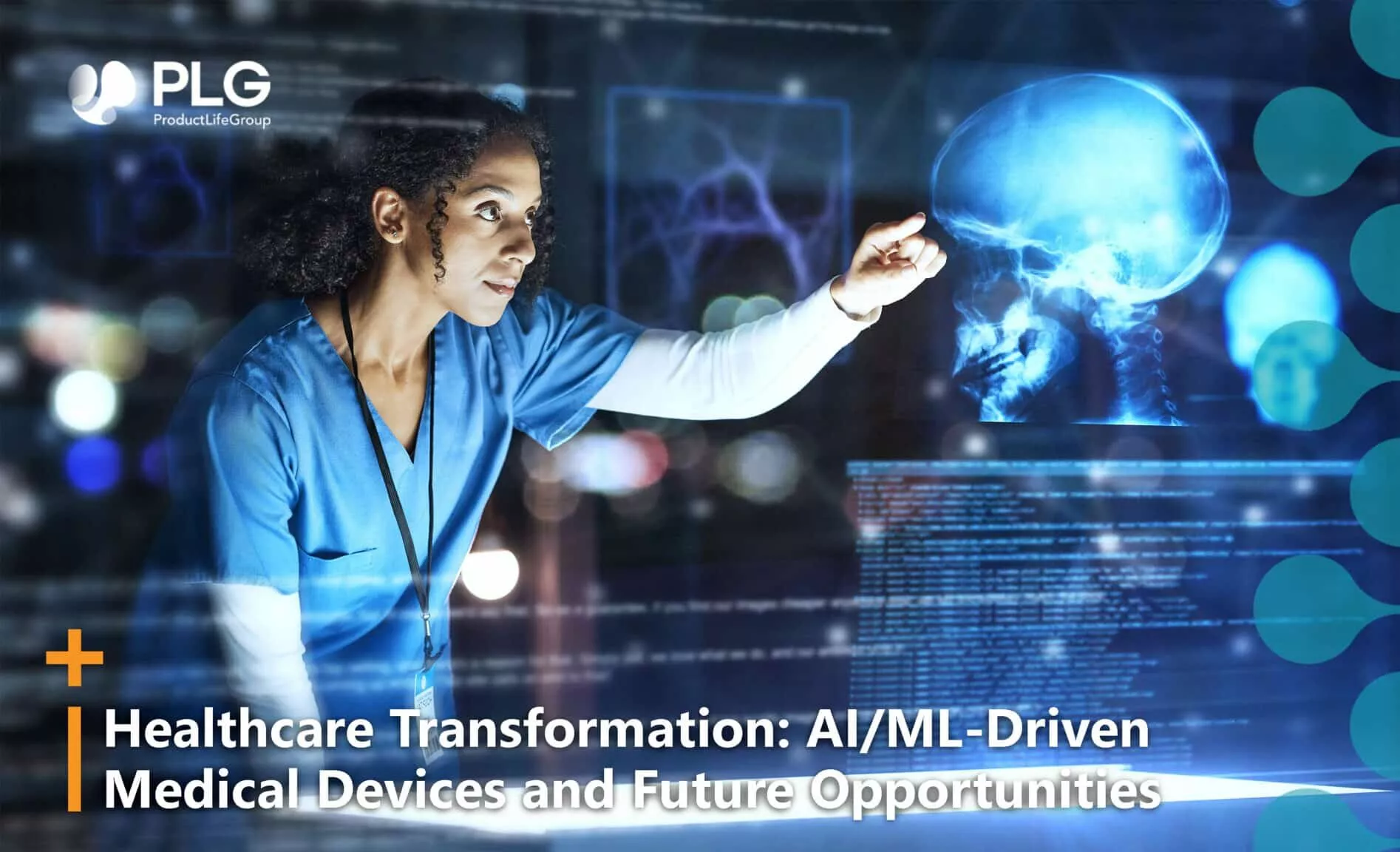
Healthcare Transformation: AI/ML-Driven Medical Devices and Future Opportunities
09 october 2023

The current use of ML/AI in the MedTech industry for diagnostics
Post-processing artificial intelligence (Al)-powered software intended to measure bone mineral density, robot-assisted joint replacements to analyze X-rays and flagging anomalies, innovative diagnostics-integrated biosensors: these are a few examples of advanced solutions that boost the MedTech market, open the doors to the use of artificial intelligence (AI) and machine learning (ML), that will become a primary driver of medical device innovation globally.
These improvements in the biomedical domain are gaining significant interest and hold considerable potential for the future of healthcare, particularly in the context of in vitro diagnostics. The European Medical Device Regulation (MDR) and In Vitro Diagnostic Medical Device Regulation (IVDR) explicitly include software in their requirements. This poses significant challenges for IVDs and MDs that involve Machine Learning (ML) algorithms for data analysis and decision support.
The potential of these new technologies is not only to diagnose but also to mitigate or prevent severe disease. AI-based IVDs can potentially improve healthcare decision-making in the coming years exponentially.
The present state of regulations governing the use of ML/AI in MedTech devices in the EU
In Europe, there are currently no laws or harmonized standards that specifically regulate the use of AI in medical devices. However, these devices must meet existing regulatory requirements, such as:
- Demonstrate the benefit and performance of the medical device under the Medical Device Regulation (MDR) and/or the IVDR
- Compliance with General Safety and Performance Requirements (MDR Annex I or IVDR Annex I)
- Ensure that the software has been developed in a way that ensures repeatability, reliability, and performance (MDR Annex I 17.1, IVDR Annex I 16.1)
- Software shall be developed and manufactured following the state of the art, considering the principles of development life cycle risk management, including information security, verification, and validation. (MDR Annex I 17.2, IVDR Annex I 16.2)
- Suppose the clinical evaluation is based on a comparator device. In that case, this device must be sufficiently technical equivalent, which explicitly includes the evaluation of the software algorithms (MDR Annex XIV, Part A, paragraph 3).
The EU’s proposed regulations for the use of ML/AI in MedTech devices
The European Union is working on a proposed AI regulation (called “AI Act”) that aims to significantly bolster regulations on the development and use of artificial intelligence and focuses primarily on strengthening rules around safety, data quality (such as transparency, traceability, and non-discriminatory), human oversight, and accountability. Once approved, the “AI Act” will be the world’s first official legislation on AI. On June 14th, 2023, the EU member states an agreement on the proposal is expected by the end of this year.
Additional Health Agencies (FDA, MHRA, and HC) proposing their own harmonized regulatory framework for the use of ML/AI in MedTech devices
In parallel, the US Food and Drug Administration (FDA), together with the UK Medicines and Healthcare Products Regulatory Agency (MHRA) and Health Canada, have jointly identified ten (10) guiding principles related to the development of Good Machine Learning Practice (GMLP). These guiding principles will help promote safe, effective, high-quality medical devices using artificial intelligence and machine learning (AI/ML).
The ten (10) guiding principles are as follows:
- Multi-disciplinary expertise is leveraged throughout the total product life cycle.
- Sound software engineering and security practices are implemented.
- Clinical study participants and data sets are representative of the intended patient population.
- Training data sets are independent of test sets.
- Selected reference datasets are based on the best available methods.
- Model design is tailored to the available data and reflects the device’s intended use.
- Focus is placed on the performance of the human-AI team.
- Testing demonstrates device performance during clinically relevant conditions.
- Users are provided with clear and essential information.
- Deployed models are monitored for performance, and re-training risks are managed.
More initiatives covering the use of ML/AI in MedTech devices
Some Initiatives are carried out into other regulatory platforms to bring AI capabilities to innovative medical devices,
- The MHRA launched 2022 the Software and AI as a Medical Device Change Programme, a program of work to ensure regulatory requirements for software and AI are clear and patients are protected. Innovative Devices – Software Group works across the MHRA to achieve this aim for SaMD and AIaMD through main innovative changes (for details, see ref page
- In April 2023, the FDA released a draft guidance called “Marketing Submission Recommendations for a Predetermined Change Control Plan for Artificial Intelligence/Machine Learning (AI/ML)-Enabled Device Software Functions.” This draft guidance proposes a science-based approach to ensuring that AI/ML-enabled devices can be safely, effectively, and rapidly modified, updated, and improved in response to new data.
ProductLife Group supports clients in understanding global ML/AI regulations for a successful registration of their MedTech products
As we stand at the threshold of a new era, the MedTech industry finds itself on the brink of remarkable transformation. From groundbreaking advancements in medical devices and diagnostics to the convergence of technology and healthcare, the future holds immense promise and potential.
PLG will continue to expand its team of experts to support customers in a flexible, customized, yet cost-efficient way. Please find out how we can support you in placing your innovative device on the market: contact us here.
References
- https://www.europarl.europa.eu/news/en/headlines/society/20230601STO93804/eu-ai-act-first-regulation-on-artificial-intelligence?&at_campaign=20226-Digital&at_medium=Google_Ads&at_platform=Search&at_creation=RSA&at_goal=TR_G&at_advertiser=Webcomm&at_audience=artificial%20intelligence%20legislation&at_topic=Artificial_intelligence_Act&at_location=FR&gclid=CjwKCAjwzo2mBhAUEiwAf7wjkkIedz9VdChjr9r6PjmQOPgTGDIJ_fw1hWZHDvvLgsHGxoSvN_OuRRoCbhoQAvD_BwE
- https://www.europarl.europa.eu/news/en/press-room/20230609IPR96212/meps-ready-to-negotiate-first-ever-rules-for-safe-and-transparent-ai
- https://www.fda.gov/medical-devices/software-medical-device-samd/good-machine-learning-practice-medical-device-development-guiding-principles
- https://www.gov.uk/government/publications/software-and-ai-as-a-medical-device-change-programme/software-and-ai-as-a-medical-device-change-programme-roadmap
- https://www.fda.gov/regulatory-information/search-fda-guidance-documents/marketing-submission-recommendations-predetermined-change-control-plan-artificial
Register to our news and events
Go to our Events to register
Go to our News to get insights
